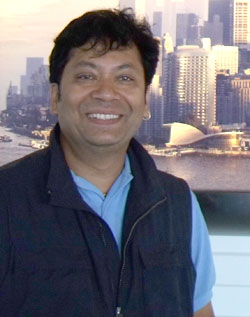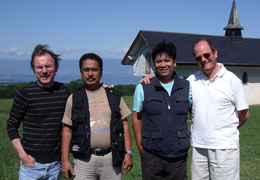


Surendra Biography

The penchant for playing table came into the mind of SURENDRA SHRESTHA when he was barely eight. His imitated what others played in tabala. At such tender age, he accompanied other musicians and dancers at religious ceremonies and family functions. He began to learn playing tabla at the age of nine under the well known Nepal tabla player Raju Agrawal. He learned many things about the art of playing tabla from Raju Agrawal including providing accompaniment for folkloric and modern songs. He began to retrace traditional rhythms when he was fourteen, seriously pursuing classical studies for the next eight years with Hom Nath.
Upadhaya and has learned many things in classical music. In 1987, Surendra shrestha took a series of trips to Benaras, India, to study tabla with Pandit Chhote Lal Mishra, the principal of Music University, Kashi Hindu Bhiswa Vidhyalaya. He continued visiting India at least once a year to pursue further classical training. He learned the finer pointes of professional performing techniques and had classical traning form Pandit Chotelas Mashra. Shrestha has obtained a distinction with first division in Master in Music form Sangeet Praveen, India.
A commerce graduate, Shrestha was place third in a classical music competition held in Kathmandu in 1994, sponsored by the Examination Board of Kalanidhi University, India. His first public performance was in 1985 at Nepal's National Theater. Shrestha debuted professionally in 1985 at a restaurant in Kathmandu . He taught tabla to private students from 1985 to 1988 before forming Sur-sudha at 1987. He received an award from Kala Nidhi Mahavidyalaya as a solo tabla player and another from the adult Organization.
History Of Tabla
The history of this instrument is uncertain, and has been the subject of sometimes heated debate. Rebecca Stewart suggested it was most likely a hybrid resulting from the experiments with existing drums such as pakhawaj, dholak and naqqara. The origins of tabla repertoire and technique may be found in all three and in physical structure there are also elements of all three: the smaller pakhawaj head for the dayan, the naqqara kettledrum for the bayan, and the flexible use of the bass of the dholak.
Sitar player Shahid Parvez Khan at a concert accompanied by the great Tabla wizard of the Benaras Gharana Pandit Samta Prasad
A common legendary account credits the 13th century Indian poet Amir Khusrau as the inventor by splitting the single South Indian mrudangam drum into two or the North Indian pakhawaj in two. ('toda, tab bhi bola - tabla': 'When broke, it still spoke' - a fairly well-known Hindi pun) None of his writings on music mention the drum, but this apparent tradition of late invention, combined with the absence of the instrument in South Indian music, and that the tabla closely resembles a Mrudangam cut into two,the closed-ended, paired design that relates it to the Western clay-drums and tympani, altogether supports the view that the tabla is a comparatively recent development in northern Indian music. Other accounts place the invention of this instrument in the 18th century, and the first verifiable player of this drum was Ustad Suddhar Khan of Delhi.
The Muktesvara temple (6th-7th century) and Bhuranesvara (and three other cave temples) of Badari in Bombay (6th century) contain depictions of the puskara drum. Musicians often placed the puskara's smaller vertical drum (called 'alinga'), on their lap and played more than one drum at a time. Similar regional instruments include the Punjabi dukkar, the Kashmiri dukra, the duggi in eastern Uttar Pradesh, and the mridangam. The mridangam (Southern equivalent of the Northern pakhavaj) is the principal drum in Carnatic music. The dhol (dholak) of eastern Afghanistan is related in terms of both construction and playing style. The main distinction of the tabla is the pairing of two different types of single-headed drums, whereas the dukkar, dukra, and duggi are pairs of the same type and the mridangam and dhol are double-headed, barrel-shaped drums. [http://en.wikipedia.org/wiki/Tabla]

Upcoming Performance
Tour 2018
- China in May
- India in June
- USA in October
- China in October
- Europe in November
( Previous Performance )




